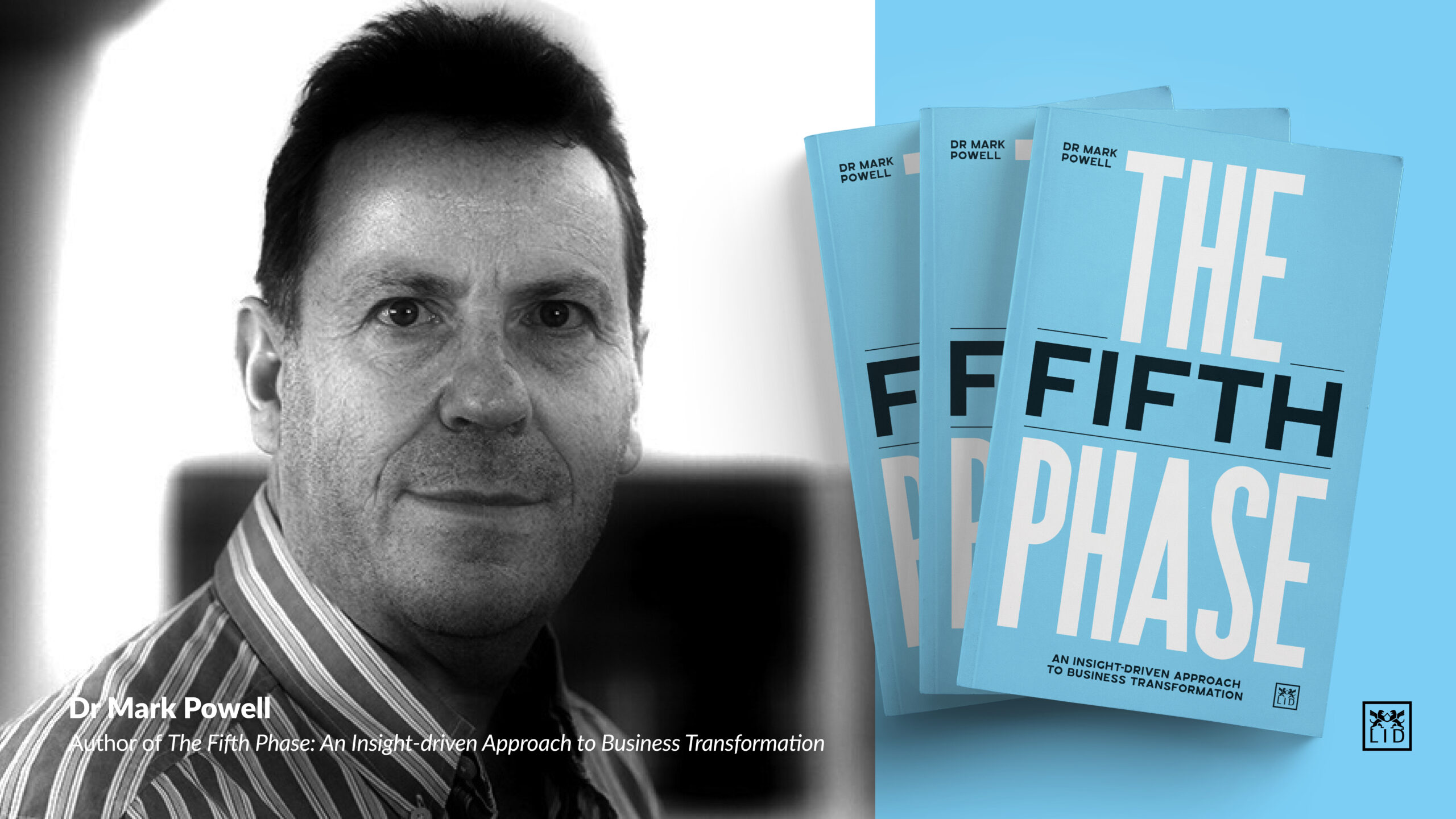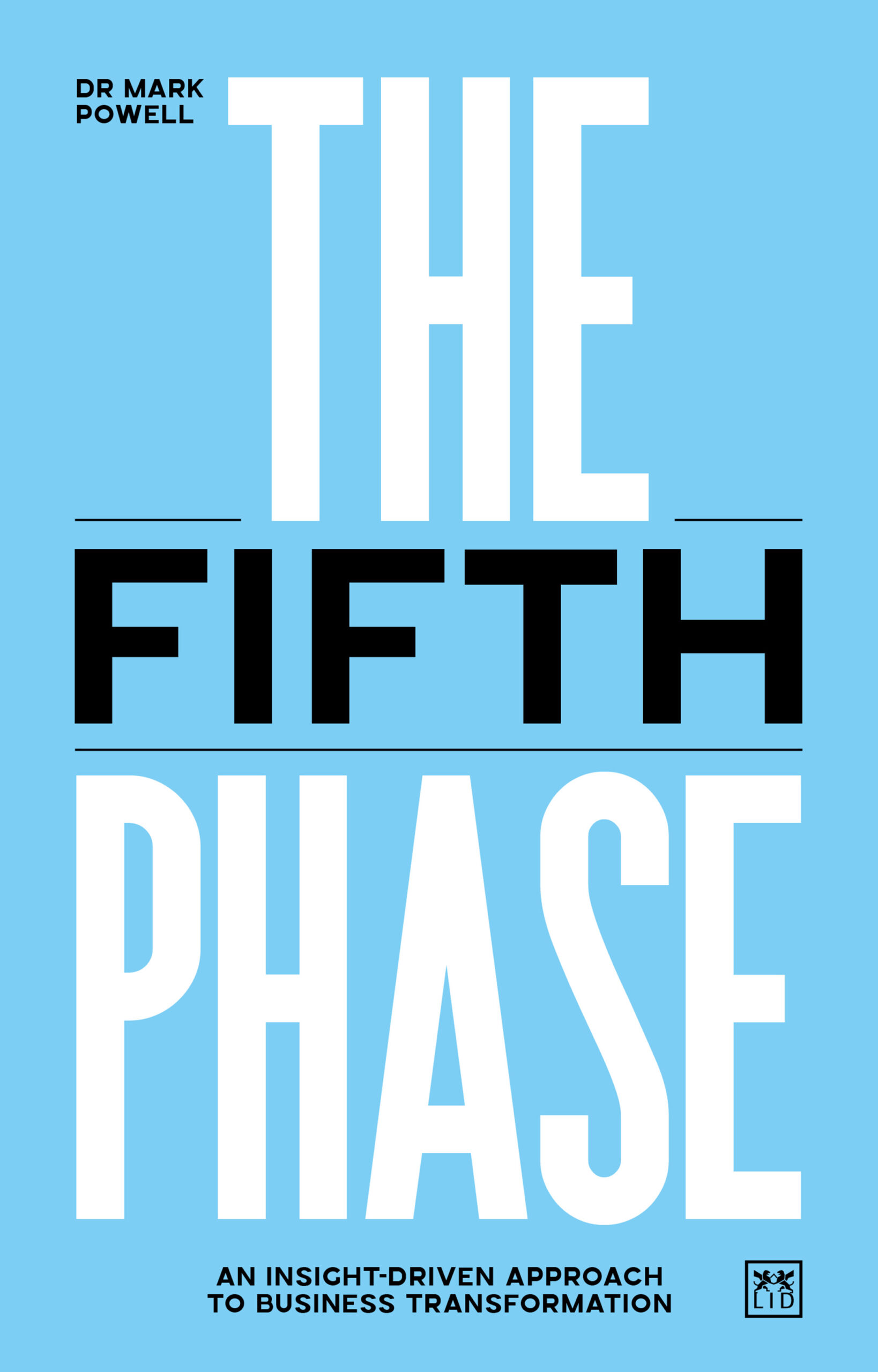|
Data Analytics, AI and the Fifth Phase of Business Transformation with Mark Powell
Data Analytics, AI and the Fifth Phase of Business Transformation

By Guest Contributor Dr Mark Powell
Author of The Fifth Phase, Dr Mark Powell, discusses how we can use data to drive business growth and profitability and stop drowning in data lakes.
In my latest book, The Fifth Phase: An Insight-driven Approach To Business Transformation, I suggest there have been four main phases of business transformation and that we are about to enter a fifth phase. I have been a business and strategy consultant for over 30 years, so know a bit about ‘business transformation’. I’ve also seen enough of the earlier phases of business transformation to be certain that this latest fifth phase – insight-led, data-enabled and using Artificial Intelligence (AI) to supercharge data analytics – will be genuinely revolutionary.
In the book, I argue that the first three phases of business transformation were, in effect, useful but not as truly transformational as often suggested. They made business processes more efficient – sometimes dramatically more efficient – but they took existing processes and improved them, rather than genuinely transforming them. “Can we squeeze 2% more efficiency out of this operation?” interests me far less as a question than, “Could we approach this in a completely different way and reimagine our entire business?”
Back in the late 19th century, an engineer called Frederick Winslow Taylor pretty much invented the concept of management consultancy and business transformation by applying some basic scientific principles to emerging industries, using observation and measurement to find more efficient ways of carrying out essential processes. These ranged from very basic things, like loading pig iron onto a railroad car, to more complex things, like the most efficient way to use machine tools to produce manufacturing components. Taylor and his colleagues invented the ‘time and motion study’ to eliminate inefficient practices on the factory floor. He called his approach ‘Scientific Management’ and it has been hugely influential in management consultancy – not entirely for the good; ‘Taylorism’ has become a shorthand for over-management and the stifling of creativity caused Taylor’s insistence on settling on ‘the one best way’.
Scientific Management in its various forms was the dominant approach for the early part of the twentieth century. It represents the first phase of business transformation. The arrival of affordable and accessible computing power in the middle of the century led to a second phase that I have called ‘Taylorism with computers.’ Advances in software and computing power led to increasingly automated attempts to improve the efficiency of manufacturing processes. This led to what became known as Material Requirements Planning (MRP), which morphed into the more all-encompassing Manufacturing Resource Planning, also known as MRP II. This was succeeded by ‘Enterprise Resource Planning’ (ERP) which began to broaden the horizon beyond the manufacturing process to include all a corporation’s key functions.
The third phase was dominated by Total Quality Management, Lean Manufacturing and Six Sigma. They all represented further attempts to drive greater efficiency in commercial processes by eliminating defects and errors. I argue in The Fifth Phase that the success of Six Sigma, in particular, results from the fact that the senior management teams of many major corporations adopted the methodology with great zeal and applied it rigorously – spurred on by Six Sigma evangelists such as Jack Welch of GE. Six Sigma set out to identify the key business issues that could deliver the most value if they were fixed, and then devoted a great deal of resources to the search for a solution. That’s likely to be an effective approach, regardless of the underlying methodology. If ERP and its fellows were ‘Taylorism with computers’, then Six Sigma was ‘Taylorism on Steroids’: seeking to reduce variations in any process to no more than 3.4 per million – the six deviation points from the mean (six ‘sigma’) that gave the movement its name. It still has its adherents, but I’ve never been a fan. I have more affection for Lean Manufacturing, which grew out of Japanese car manufacturer Toyota’s quest for continuous improvement, driven by constant input and refinement from the people working on its production lines. Lean Manufacturing and Six Sigma were merged by some practitioners into Lean Six Sigma, which can probably be seen as the apogee of ‘process management.’
Then came the personal computer, the internet and the tech revolution. The world had changed. What was the point in making an existing process efficient to 3.4 defects per million, if the whole business model on which it was based could be destroyed the next day by some revolutionary new piece of tech?
Data is not the new oil
The fourth phase, of course, was big data. The internet and mobile telephony were generating data at an unprecedented rate. Those data were undoubtedly of potential interest – we were acquiring an awful lot of data about consumers preferences and actions, for example. A new mantra emerged: “Data is the new oil.”
The first person to say this may have been Clive Humby, the British mathematician and data scientist behind the Tesco Clubcard, who, according to The Guardian newspaper, coined the phrase back in 2006. He was soon joined by a chorus of others. Meglena Kuneva, the European Consumer Commissioner, observed in 2009 that, “[p]ersonal data is the new oil of the internet and the new currency of the digital world.” This sounds exciting and compelling at first hearing, but it overlooks the fact that unrefined oil is not valuable in itself; it needs to be refined. Peter Sondergaard, the SVP of the technology consultancy, Gartner, got it more right when he said in 2011 that, “[i]nformation is the oil of the 21st century, and analytics is the combustion engine.” Oil has value when you refine and use it to run some sort of engine (or to make a huge range of oil-based materials). Organisations made the mistake of thinking that data have intrinsic value. They don’t. They have potential value, but that value can only be realised via data analytics. You need to interrogate data, which means you need to have some idea of the kind of insights that have the potential to transform your business so you can pose meaningful questions that data analysts can try to find answers to.
I still have regular conversations with business executives who tell me they are trying to work out how much their data is worth. I give them a rather blunt response: “Your data is worth nothing.” It’s a bit harsh, but unless you know what you can do with your data, all you are doing is wasting money managing it. The typical end result of the ‘dash for data’ was vast and expensive data lakes from which one ever got to drink and in which many people drowned.
Most ‘big data’ projects failed. As early as 2014, a Capgemini study found that only 27% of big data projects were regarded as “successful,” with just 13% of organizations claiming they achieved full-scale production for their big data implementations. Businesses were struggling with both technical challenges in handling scattered silos of data and organizational hurdles such as ineffective coordination among analytics teams. A little later, in 2016, Gartner, estimated that about 60% of big data projects were failing. A year later, Gartner analyst Nick Heudecker put it at closer to 85%. NewVantage Partners’ 2019 Big Data and AI Executive Survey provided further corroboration, with 77% of executives reporting that the business adoption of big data initiatives was proving to be a major challenge.
For the last 10 or 15 years, business leaders have been obsessed with big data, shelling out millions building data lakes and data warehouses in the hope that if they pooled every conceivable piece of data together, valuable business insights would magically arrive. It doesn’t work like that. I fear that, apart from companies like Amazon and the cloud services businesses who have been selling data solutions like hot cakes, most organizations are in roughly the same position they were a decade ago. The fourth phase of business transformation has produced precious little transformation.
Finding the right questions
Many of the operational challenges of dealing successfully with data stemmed from human problems, not technical failures. Despite announcing their move towards a data-first strategy, many company executives didn’t actually put the data first. They assigned the challenge, understandably, to their IT teams. But most IT departments weren’t given any meaningful business context for the task they were being charged with. Data isn’t just about technology. It isn’t “something the IT department should deal with”, It’s about driving business outcomes from data-based insight.
We started our approach to big data from a data up position, and we needed to move to value down – going back to the drivers of value for our businesses and deciding which insights, if they could be generated from available data, would drive the outcomes that would deliver the best business result.
The ‘value down’ approach forces us to identify what we want to achieve, the questions we need to ask, and the hypotheses we can formulate around those questions that will allow us to test the data to see if they can deliver. Data will not magically provide us with answers. There is no mysterious algorithm that can be ‘let loose’ on a mass of undifferentiated data to produce a meaningful business answer. We have to decide what business problems it would be most valuable to and then look for the data that might hold the answer and the data analytic methodology that might be able to unlock that insight.
I fear that the fourth phase of business transformation – the dash for data – has represented a lost decade in terms of business transformation. The fifth phase – insight-led, data-enabled and supercharged by AI – genuinely has the power to allow us to reimagine our businesses.
ABOUT THE AUTHOR
Suggested Reading
 Big data has new and exciting answers to offer, but business leaders must first decide what questions it would like to see answered. Data may be the new oil, but to date we have only built oil depots. This book analyses the new, Fifth Phase of business transformation, which will build the refineries that turn data into useful products. Business has started from ‘data up’ and needs to start again from ‘value down’, going back to the drivers of real business value and deciding what insights would help realize that value. Only then can we begin to interrogate data with purpose.
Big data has new and exciting answers to offer, but business leaders must first decide what questions it would like to see answered. Data may be the new oil, but to date we have only built oil depots. This book analyses the new, Fifth Phase of business transformation, which will build the refineries that turn data into useful products. Business has started from ‘data up’ and needs to start again from ‘value down’, going back to the drivers of real business value and deciding what insights would help realize that value. Only then can we begin to interrogate data with purpose.

